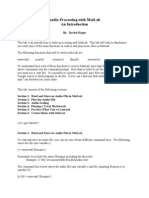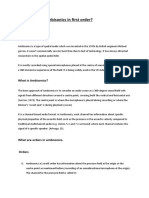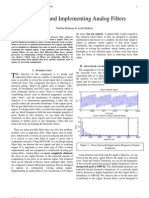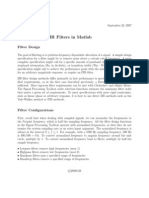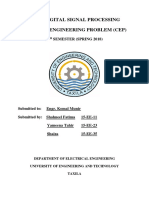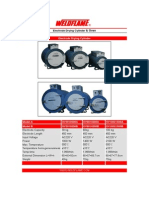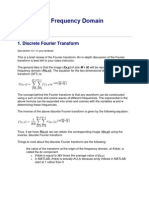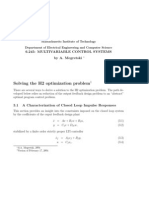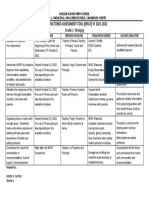MATLAB for Audio Signal Processing MATLAB for Audio Signal Processing
P. Professorson UT Arlington Night School
Getting real world data into your computer Analysis based on frequency content
Fourier analysis Filtering signal bands
Modifying the spectrum
FIR filters IIR filters
Other stuff
Getting data into the computer
Aliasing
Sampling frequency must be high enough to characterize the signal correctly.
Microphone
Anti-Aliasing filter
Sample & Hold
Analog to Digital converter
DSP system
Fs >= 2 fmax
For a given Fs, signal components higher than Fs/2 (Nyquist frequency) are forcibly removed using an anti-aliasing filter prior to sampling.
Continuous Analog
Discrete (fixed bits per sample) Digital
�Blue signal : 5 Hz Red signal : 30 Hz Sampling frequency : 80 Hz Nyquist frequency : 40 Hz No aliasing in either signal.
Audio signals
Audio spectrum for music lies between 20Hz to 20KHz This gives a Nyquist sampling rate of 40KHz CD audio uses a sampling rate of 44.1 KHz 16 bits per sample WAV files store uncompressed samples MP3 files store compressed data
Sampling frequency : 40 Hz No aliasing in blue signal. Nyquist frequency : 20 Hz Aliasing in red signal. The 30 Hz signal manifests itself as a 10 Hz signal in the sampled system.
Importing audio in MATLAB
Playing back your audio
Create an audioplayer object
WAV files:
ap = audioplayer(data, sr);
[data sr nbits] = wavread('song.wav'); sr: sampling rate nbits: number of bits per sample For mono audio, data is a vector containing audio samples For stereo audio, data is a 2-D vector
Play the audio file using the object just created
play(ap);
This plays the audio in the background while the rest of your scrip continues working. isplaying(ap) returns 1 if the file is still playing, and 0 if the file has finished playback. This halts execution till the audio clip stops playing
MP3 files convert them to WAV format using an external MP3 decoder, then use wavread
playblocking(ap);
�Audio spectrum
Discrete-time Fourier Analysis
Human ear's response is non-linear. It is good at discriminating low frequencies, but not so good at distinguishing between higher frequencies. Spectrum analyzers on music players have logarithmic frequency scales. Octave is a frequency scale that doubles at every level.
Discrete Fourier Transform gives a discretefrequency representation of a discrete time signal. An N-point DFT of a signal will produce N numbers, each representing the signal content at uniformly spaced frequencies between - Fs/2 to + Fs/2 (not in that order). Fast Fourier Transform (FFT) is a (class of) algorithm(s) that produce the DFT efficiently - O(N*log(N)) vs O(N2) for regular DFT.
F1 = 30Hz, F2 = 60Hz, F3 = 120Hz
MATLAB's FFT
FFT fun facts
f = fft(signal, N);
f = fft(signal, N);
f(1) is the DC component / signal average
Useless with respect to audio spectrum
Produces N-point DFT of a signal N should be > length of signal to preserve fidelity, preferably a power of 2 for efficiency
f(2) is the strength at frequency Fs/N f(k) is the strength at frequency (k-1)*Fs/N f(N/2+1) is the strength at Nyquist frequency Fs/2
For a real signal, f is generally complex. Its absolute value is used to specify its strength. signal2 = ifft(f, M)
Useless as it varies with phase of the signal
Beyond this are negative frequencies which are mirror images of positive frequencies (for real signals) f needs to be scaled as f*2/N FFT bins represent the exact frequency. Frequencies lying between bins are not accurately represented. 20*log10(abs(f));
http://www.zytrax.com/tech/audio/equalization.html
Reproduces a signal of length M whose Npoint DFT is specified in f
Signal power spectrum in decibels is given by
�Direct FFT spectrum modification
Disadvantages of the FFT method
We can modify the shape of the spectrum 'f' before we invert it. Need to avoid abrupt changes in bands. f_new = f .* desired_gains; signal_new = ifft(f_new, N1);
FFT is good for analysis of the signal, but not good for changing the signal spectrum because: FFT assumes that the signal is periodic, i.e. the signal supplied to it repeats itself.
This is not true in real life We need to apply a window function so that the signal decays to zero at it's both ends.
N1 is the length of the original signal
FFT order needs to be greater than the signal's length to allow faithful reproduction using inverse FFT.
Band-pass filter banks
Time-domain filters
Audio spectrum is divided into non-uniformly spaced bands the ones you see on an equalizer.
Finite Impulse Response (FIR) filters Infinite Impulse Response (IIR) filters What is impulse response?
Input x(n) LTI System Output y(n)
Audio is passed through each filter, and the signal content at the output gives the content in that frequency band.
Filter 1: 22 Hz 44 Hz, Filter 2: 44 Hz 88 Hz Filter 3: 88 Hz 176 Hz, ... Filter 9: 5.5 Khz 11.5 Khz, Filter 10: 11.5 Khz 22 KHz
This relationship can be expressed as y(n) = x(n) * h(n) Where * is the convolution operation, and h(n) is called the system's impulse response. Most operations like frequency selective filtering, averaging, etc. are linear. Non-linear operations such as median filtering cannot be performed with convolution.
�FIR filters
FIR design steps
The impulse response h(n) is finite length Can be implemented as Impulse response has N coefficients h(1) to h(N), also referred to as b0, b1, .. bN-1 as shown in the fig. N is called the filter order We need access to N past values of x to perform this operation. A circular buffer of size N is used to store these in a realtime system.
Determine the desired frequency response
Find h(n) using inverse Fourier transform
This h(n) has infinite elements.
Truncate it to N elements using a window function. Using an abrupt rectangular window will cause ringing artifacts. (Gibb's phenomenon) A smoothing window such as a Hamming window is used.
The final step is to shift the whole filter so that there are no samples in negative time.
h=h*
The negative time samples imply that the filter needs to access future N/2 values of x, ahead of current time n. This results in a filter delay, as we need to wait for the next N/2 samples to arrive before producing a valid output.
�FIR filters in MATLAB
IIR Filters
Structure is very similar to FIR filters, except that output y is also fed back through weights an. We need to store N previous values of x and y. The required filter order N is much smaller than FIR filters for the same performance.
b = fir1(N, wcn) produces an FIR filter with N+1 coefficients.
wcn is the normalized cutoff frequency for a low pass filter with cutoff fc Hz, wcn = fc/fNyquist For a band pass filter with cutoffs fcl and fch, wcn = [fcl fch]/fNyquist. Remember that fNyquist = Fs/2 fvtool(b);
To visualize this filter, use the filter visualization tool:
How to obtain ans and bns?
How MATLAB will do it
Given your filter specs, determine whether you need a Butterworth filter, Chebyshev-I/II filter, or an Elliptical filter. Look up the corresponding command from documentation. Each command has a number of option to specify your filter specs. [b a] = butter(N, wc); will produce a Butterworth filter of order N, with normalized cutoff frequency(ies) given in wc. The filter co-efficient are conveniently returned.
For Band Pass response, the filter order is 2*N, and wc = [fc1 fc2]/fNyquist
�Applying the IIR filter to a signal
FIR vs IIR
Both have their merits and applications FIR filters produce a linear phase response, while IIR filters severely distort the phase. FIR filters need a much higher order than an IIR filter to obtain the same quality of response. Consequently the filter delay is considerably large for FIR filters. FIR filters are inherently stable, while poorly designed IIR filters may over/underflow, and IIR filters are also affected by precision a great deal.
y = filter(b, a, x); will apply the IIR filter represented by arrays b and a to the signal x, producing the filtered output y. If x is windowed, the filter's final conditions must be passed as initial conditions when filtering the next window.
To visualize this filter, use the filter visualization tool:
fvtool(b, a);
MATLAB MP3 reading functions: http://labrosa.ee.columbia.edu/matlab/mp3read.html Octaves frequency scale: http://www.recordingeq.com/EQ/req0400/OctaveEQ.htm
Web References
Spectrum Analysis Windows: https://ccrma.stanford.edu/~jos/sasp/Spectrum_Analysis_Windows.html
Spectrum Analyzer Implementation on DSP: http://cache.freescale.com/files/dsp/doc/app_note/AN2110.pdf
FFT Spectrum Analyzers: http://www.thinksrs.com/downloads/PDFs/ApplicationNotes/AboutFFTs.pdf
FIR filters: http://www.cems.uvm.edu/~mirchand/classes/EE275/2011/Matlab/Lab6.pdf
IIR filters: http://ssli.ee.washington.edu/courses/ee518/notes/lec16.pdf
Equalization and other DSP implementations: http://www.zytrax.com/tech/audio/equalization.html

